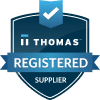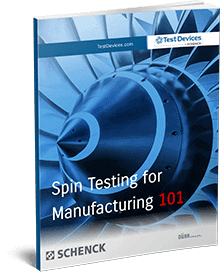Spin Testing Services
Test Devices by SCHENCK serves customers who work with high-speed rotating components of cutting-edge machines operating under arduous conditions, as found in jet engines, turbomachinery, high-speed electric motors, and energy storage systems. We serve a long list of customers, including many leading OEMs, by providing innovative solutions to challenging problems in engineering testing and manufacturing spin processes. Test Devices offers various spin testing and rotor balancing services to support design validations, critical engine part certifications and manufacturing processes.
See the links below to find more about Test Device's Spin Testing and Balancing services. Download our Spin Testing e-book to learn more about the subtle art of achieving a high-quality spin test for manufacturing processes.
Spin Tests For Manufactured Parts
-
Overspeed Testing
Overspeed Testing
Proof and Overspeed testing are a mainstay for manufacturers of turbomachinery and other rotating equipment. Essentially, a rotating component is accelerated to a certain speed greater than that ever seen in operation. Overspeed testing is included in the FAA certification of aircraft turbine engines. Test Devices has conducted many such tests.
-
Forging Pre-Spin
Pre-Spin Testing
When new designs or materials are being introduced, more thorough test data is often required to validate predicted growth models. Test Devices can measure elastic and plastic radial growth of components in real time while rotating. This technique can verify stress and growth models and determine precise gaps between rotating and stationary components in turbomachinery.
Spin Tests For Design Validation
-
Burst Testing
Burst Testing
Spin burst testing provides customers with an efficient method to validate rotor designs and establish component safety margins. All tests are performed under the safest conditions, in a robust spin chamber installed in a test cell with double-reinforced concrete walls and ceiling. Optional high speed video recording of the burst event can provide invaluable information about the rotor failure mechanism.
-
Low Cycle
Fatigue TestingLow Cycle Fatigue Testing
Establishing the fatigue life of a rotating component is critical to establish safe working life criteria. Test Devices offers LCF spin testing services with rapid cycling capability that accelerates fatigue testing programs, providing customers with life-assessment data earlier. Optional crack detection can monitor component integrity in real time, enabling a test to be stopped prior to rotor failure.
-
Dynamic
Spin TestingDynamic Spin Testing
Test Devices’ Dynamic Spin Testing of bladed disks provides the ability to excite airfoil and disk vibratory modes of fully or partially bladed engine rotor stages. This dynamic testing method enables characterization of the vibratory performance of blade designs to evaluate the effectiveness of damper designs and to assess the high cycle fatigue life of blade and damper systems. Tests can be conducted at ambient temperature or elevated temperatures exceeding 1000°F.
-
Thermal Gradient
Thermal Gradient
During operation, rotating components are exposed to stresses due to thermal gradients that can exceed the centrifugal stresses. Test Devices can provide customers with more relevant test data by performing spin proof tests with thermal gradients that more closely simulate the complete stress state experienced by components in operation.
-
Overspeed Certification
Testing (Proof Testing)Overspeed Certification Test (Proof Testing)
Proof and Overspeed testing are a mainstay for manufacturers of turbomachinery and other rotating equipment. Essentially, a rotating component is accelerated to a certain speed greater than that ever seen in operation. Overspeed testing is included in the FAA certification of aircraft turbine engines. Test Devices has conducted many such tests.
Add-On Services
Value Props
Balancing Services
Spin Testing and Balancing Services often go hand-in-hand.
Learn more about our balancing services here!





